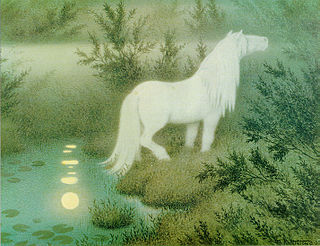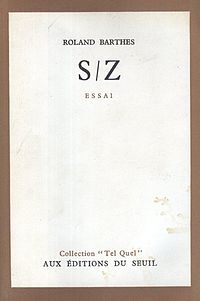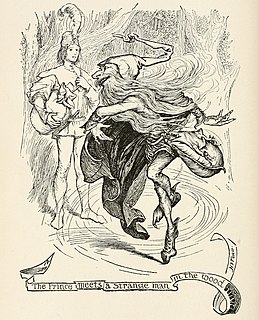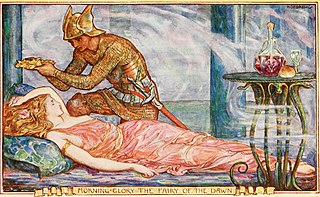Irrealism is a term that has been used by various writers in the fields of philosophy, literature, and art to denote specific modes of unreality and/or the problems in concretely defining reality. While in philosophy the term specifically refers to a position put forward by the American philosopher Nelson Goodman, in literature and art it refers to a variety of writers and movements. If the term has nonetheless retained a certain consistency in its use across these fields and would-be movements, it perhaps reflects the word’s position in general English usage: though the standard dictionary definition of irreal gives it the same meaning as unreal, irreal is very rarely used in comparison with unreal. Thus, it has generally been used to describe something which, while unreal, is so in a very specific or unusual fashion, usually one emphasizing not just the "not real," but some form of estrangement from our generally accepted sense of reality.
"On Fairy-Stories" is an essay by J. R. R. Tolkien which discusses the fairy-story as a literary form. It was written as a lecture entitled "Fairy Stories" for the Andrew Lang lecture at the University of St Andrews, Scotland, on 8 March 1939.

The Hobbit, or There and Back Again is a children's fantasy novel by English author J. R. R. Tolkien. It was published in 1937 to wide critical acclaim, being nominated for the Carnegie Medal and awarded a prize from the New York Herald Tribune for best juvenile fiction. The book remains popular and is recognized as a classic in children's literature.
Suspension of disbelief, sometimes called willing suspension of disbelief, is the avoidance of critical thinking or logic in examining something unreal or impossible in reality, such as a work of speculative fiction, in order to believe it for the sake of enjoyment. Aristotle first explored the idea of the concept in its relation to the principles of theater; the audience ignores the unreality of fiction in order to experience catharsis.

A fantasy world is a world created for/from fictional media, such as literature, film or games. Typical fantasy worlds involve magic or magical abilities, nonexistent technology and, sometimes, either a historical or futuristic theme. Some worlds may be a parallel world connected to Earth via magical portals or items ; an imaginary universe hidden within ours ; a fictional Earth set in the remote past or future ; an alternative version of our History ; or an entirely independent world set in another part of the universe.

Damien Francis Broderick is an Australian science fiction and popular science writer and editor of some 74 books. His science fiction novel The Dreaming Dragons (1980) introduced the trope of the generation time machine, his The Judas Mandala (1982) contains the first appearance of the term "virtual reality" in science fiction, and his 1997 popular science book The Spike was the first to investigate the technological singularity in detail.
The fantastic is a subgenre of literary works characterized by the ambiguous presentation of seemingly supernatural forces.

Fantasy literature is literature set in an imaginary universe, often but not always without any locations, events, or people from the real world. Magic, the supernatural and magical creatures are common in many of these imaginary worlds. Fantasy literature may be directed at both children and adults.
Christine Frances Evelyn Brooke-Rose was a British writer and literary critic, known principally for her experimental novels.
Low fantasy, or intrusion fantasy, is a subgenre of fantasy fiction in which magical events intrude on an otherwise-normal world. The term thus contrasts with high fantasy stories, which take place in fictional worlds that have their own sets of rules and physical laws.

S/Z, published in 1970, is Roland Barthes' structural analysis of "Sarrasine", the short story by Honoré de Balzac. Barthes methodically moves through the text of the story, denoting where and how different codes of meaning function. Barthes' study made a major impact on literary criticism and is historically located at the crossroads of structuralism and post-structuralism.

Elements of the supernatural and the fantastic were an element of literature from its beginning. The modern genre is distinguished from tales and folklore which contain fantastic elements, first by the acknowledged fictitious nature of the work, and second by the naming of an author. Works in which the marvels were not necessarily believed, or only half-believed, such as the European romances of chivalry and the tales of the Arabian Nights, slowly evolved into works with such traits. Authors like George MacDonald created the first explicitly fantastic works.
The implied author is a concept of literary criticism developed in the 20th century. Distinct from the author and the narrator, the term refers to the "authorial character" that a reader infers from a text based on the way a literary work is written. In other words, the implied author is a construct, the image of the writer produced by a reader as called forth from the text. The implied author may or may not coincide with the author's expressed intentions or known personality traits.
The Ditmar Award is Australia's oldest and best-known science fiction, fantasy and horror award, presented annually since 1969, usually at the Australian "Natcon". The historical nominations and results of the Award follow.
Worldbuilding is the process of constructing a world, originally an imaginary one, sometimes associated with a fictional universe. Developing an imaginary setting with coherent qualities such as a history, geography, and ecology is a key task for many science fiction or fantasy writers. Worldbuilding often involves the creation of geography, a backstory, flora, fauna, inhabitants, technology and often if writing speculative fiction, different races. This may include social customs as well as invented languages for the world.

Gary K. Wolfe is an American science fiction editor, critic and biographer. He is an emeritus Professor of Humanities in Roosevelt University's Evelyn T. Stone College of Professional Studies.

Fantasy is a genre of speculative fiction involving magical elements, typically set in a fictional universe and sometimes inspired by mythology and folklore. Its roots are in oral traditions, which then became fantasy literature and drama. From the twentieth century, it has expanded further into various media, including film, television, graphic novels, manga, animations and video games.
The impression of depth in The Lord of the Rings is an aesthetic effect deliberately sought by its author, J. R. R. Tolkien. It was intended to give the reader the feeling that the work had "deep roots in the past", and hence that it was attractively authentic.

The far future has been used as a setting in many works of science fiction. The far future setting arose in the late 19th century, as earlier writers had little understanding of concepts such as deep time and its implications for the nature of humankind. Classic examples of this genre include works such as H.G. Wells' The Time Machine (1895) or Olaf Stapledon's Last and First Men (1930). Recurring themes include themes such as Utopias, eschatology or the ultimate fate of the universe. Many works also overlap with other genres such as space opera, science fantasy or apocalyptic and post-apocalyptic fiction.

Master of Middle-earth: The Fiction of J. R. R. Tolkien is a 1972 book of literary criticism of J. R. R. Tolkien's Middle-earth fantasy writings, written by Paul H. Kocher. It focuses especially on the best-selling novel The Lord of the Rings and The Hobbit, and also covers some of his minor works such as "Leaf by Niggle" and "Smith of Wootton Major". It was one of the earliest book-length analyses of Tolkien's work, winning Kocher the 1973 Mythopoeic Society's Scholarship in Inkling Studies Award.








